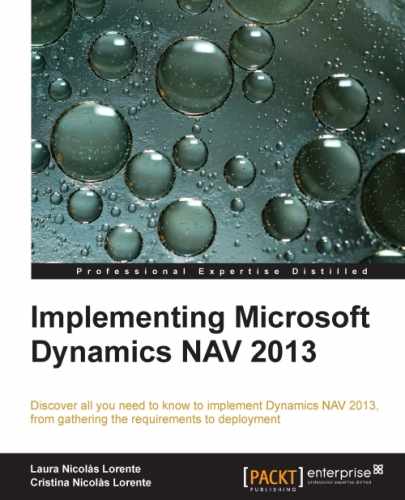In this chapter we will learn about the Dynamics NAV 2013 implementation process. We will explain the meaning of implementation and see that there are different methodologies that you can apply.
In an implementation process, several people may get involved, each one playing his/her own role. We will learn what kind of roles can be found in a Dynamics NAV implementation and the job that can be expected from each role.
We will also see that the implementation process can be broken down into phases, and we will learn about the tasks included in each phase.
The main topics discussed in this chapter are:
- Defining what an implementation is
- Using methodology
- Roles involved in an implementation project
- The phases of the project
If you pick up a dictionary and look for the definition of implementation, you will end up with something like this:
"Implementation is the carrying out, execution, or practice of a plan, a method, or any design for doing something. As such, implementation is the action that must follow any preliminary thinking in order for something to actually happen. In an information technology context, implementation encompasses all the processes involved in getting new software or hardware operating properly in its environment, including installation, configuration, running, testing, and making necessary changes. The word deployment is sometimes used to mean the same thing."
This definition has been taken from the following website:
http://searchcrm.techtarget.com/definition/implementation
I especially like the part where it says: getting new software operating properly in its environment.
That is what needs to be done in a Dynamics NAV implementation process. Get the software (Dynamics NAV) to operate properly in its environment (the company that will use Dynamics NAV as their business management software).
Don't get us wrong. That doesn't mean that Dynamics NAV doesn't work properly. It actually does. But companies are completely different from one another. They work completely different as they have different processes and ways of doing business. Dynamics NAV, just as companies, can work in many different ways. Each company has to find its own way. And that is actually what will be done in the implementation process where you choose the way in which you want Dynamics NAV to work.
Dynamics NAV is not a software product that you can just install and start working with. There are many things that have to be configured, many others that have to be decided, master data that has to be introduced in the system, and a large etcetera of things that has to be done before a company can actually start using Dynamics NAV as their business software.
Dynamics NAV, as many other business software products, provides a large stack of what is called horizontal functionality that may be useful for any company using Dynamics NAV, regardless of the business sector in which they work, and it also provides the needed flexibility to adapt to any specific vertical requirement.
Tip
Vertical and horizontal solutions
A vertical solution is a stack of functionalities thought and developed to cover industry-specific requirements of a business sector. Manufacturing companies need software solutions different from what a health care company needs, for example.
A horizontal solution is a stack of functionalities that every single company needs or can use, such as word processing or spreadsheet applications. In Dynamics NAV, application modules like Financial Management are part of the horizontal solution, as it is useful and needed for every single company.
Apart from a bunch of horizontal functionalities, Dynamics NAV offers some out of the box vertical application modules, such as the Manufacturing module, that will probably be used by manufacturing companies but not by retail companies, for instance.
All the out of the box application modules and functionalities that Dynamics NAV offers can be put together in what is called the Standard Solution or standard software . Don't take the word standard as something standardized by an international standards authority. That is not what standard means in this context. It actually refers to how the company that has developed Dynamics NAV has decided that this software solution will behave.
If standard Dynamics NAV does not meet the specific requirements a company needs, a large channel of Dynamics NAV partners exists, which may have developed a vertical solution. The solution probably complies with many of the requirements of what your company needs.
You will find vertical solutions for as many business sectors as you may think of: retail, real estate, education, or health care, just to name a few.
If that is not enough, development can be done for a specific company to modify or extend Dynamics NAV functionality to meet any kind of requirement, automate functionalities that may have to be performed manually out of the box, or any other thing you may think of.
In an implementation process of Dynamics NAV, you have to choose whether you will implement standard Dynamics NAV or a vertical solution offered by yourself or by any other company. You will have to choose which functionalities will be used and how they will be used, you have to know if development will be required, and then you have to implement all of this by installing the product, develop what needs to be developed, and configure the whole system. But that's not it. You also need to load the initial data the company needs to start working with (primarily their master data, such as their customers, vendors, or items). Finally, you have to train the end users who will use Dynamics NAV, as they have to know how everything works and which tasks they are expected to perform in the system.
